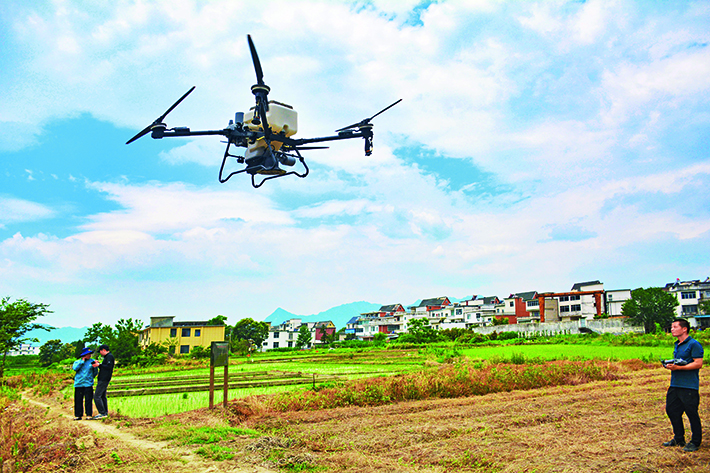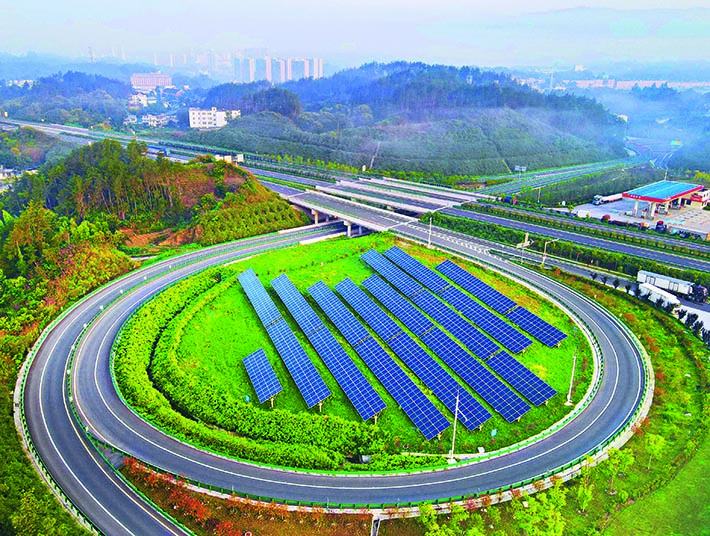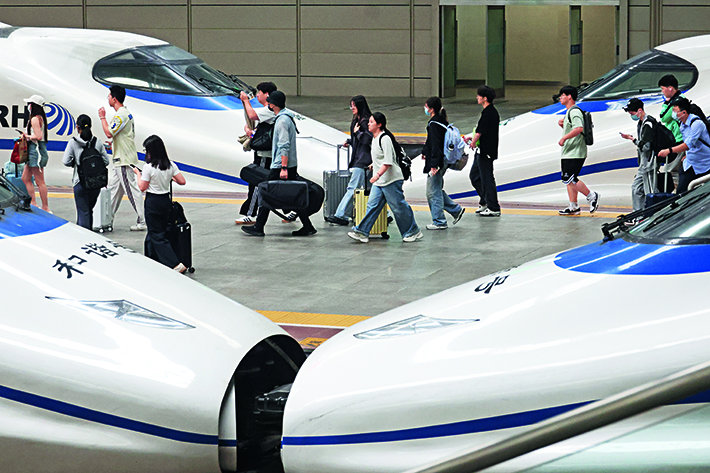|
||||||||||
| Home Top News Economy/Tech Culture/Sports China in Foreign Eyes Green Development Videos Intangible Cultural Heritages |
|
||||||||||
| Home Top News Economy/Tech Culture/Sports China in Foreign Eyes Green Development Videos Intangible Cultural Heritages |
| ChinAfrica |
| Shaping the Future |
| How Five-Year Plans have guided China’s economic and social transformation |
| By Lu Yan, Reporter, Beijing Review | VOL. 17 August 2025 ·2025-07-24 |

A drone sows drought-tolerant, water-efficient rice in Anqing, Anhui Province, on 6 June (VCG)
In July 1956, the First Automobile Works in Changchun, Jilin Province - part of the country’s traditional northeastern industrial base - produced the first car made in the People’s Republic of China (PRC). This achievement was a glimpse into the 156 key projects outlined in the country’s First Five-Year Plan (FYP) (1953-1957). Fast forward to 2024, and thanks to high levels of automation and intelligent manufacturing, major Chinese automaker BYD’s factory in Shenzhen, Guangdong Province, is able to roll out a new electric vehicle every minute, highlighting the advancements in high-end manufacturing as detailed in the 14th FYP (2021-2025).
The five-year plan, also known as the Five-Year Plan for National Economic and Social Development, is a key guiding document for China’s medium- to long-term economic and social progress. It outlines the country’s overall goals, main tasks and policy orientation across different sectors over a five-year period.
Hailing the five-year plans as “strategic and flexible,” British scholar and political commentator Martin Jacques told Xinhua News Agency, “The five-year plans are suited to the Chinese mentality and the Chinese idea of thinking long-term.”
This year is the final year for the implementation of the 14th FYP. The 2025 Government Work Report, released in early March, underscores the importance of fully completing the plan’s objectives, so as to lay a solid foundation for a strong start to the 15th FYP (2026-2030).
The evolution
Since the launch of the First FYP, these plans have not only guided China’s transformative development, but also evolved to meet the conditions and challenges of each era.
For example, the First FYP was introduced in the early years following the founding of the PRC in 1949, when the economy was weak and the industrial base was almost nonexistent. As a result, the plan focused heavily on industrialisation, the development of heavy industry in particular.
In contrast, with the country’s fast development, the Sixth FYP (1981-1985) included social development goals, reflecting the broader reforms being implemented across various sectors, including science and technology, education, culture and health care. The Ninth FYP (1996-2000) aimed for moderate prosperity, while the 13th FYP (2016-2020) emphasised achieving a moderately prosperous society in all respects.
One major characteristic of the five-year plans is the incorporation of quantitative targets. The Seventh FYP (1986-1990) was the first to set a specific target for GDP growth, a gauge of a country’s economic health. Meanwhile, the 11th FYP (2006-2010) set an ambitious goal for energy efficiency, aiming for a 20-percent reduction in the energy intensity of the country’s GDP. Since 2006, the plan has adopted a system comprising both obligatory targets and anticipatory targets, covering both the government’s responsibilities and society’s participation.
The 14th FYP, launched after China achieved the goal of building a moderately prosperous society in all respects, focused on high-quality development. It did not set an explicit GDP growth target but instead prioritised green transition, technological self-reliance, common prosperity, balanced regional development, as well as deeper reform and high-standard opening up.
Today, a five-year plan covers a broad range of fields including economy, society, technology, ecology and culture, reflecting a holistic approach to development.

Photovoltaic panels installed along the Shanghai–Wuhan Expressway, framed by green belts, in Yuexi, Anhui Province, on 17 June (VCG)
The compilation
The formulation process of a five-year plan follows a structured framework that combines the leadership of the Communist Party of China (CPC) Central Committee with broad public participation. A plenary session of the CPC Central Committee puts forward its proposals for the formulation of the plan. The State Council, the highest state administrative organ, then drafts an outline for the plan, which is later reviewed and approved by the National People’s Congress, China’s national legislature, before being officially published - and subsequently implemented.
Throughout the entire process, public input and expert opinions are carefully considered. These arrangements gather insights and experiences from different sectors, reflect public expectations and build consensus.
The decision-making process includes multiple rounds of discussions, research and feedback, with the goal of gathering diverse opinions and maximising quality input from all parties involved.
This process typically spans several years. For instance, the drafting of the current 14th FYP, adopted in 2021, began as early as 2018.
The outcomes
Tangible results have been achieved under the plans’ guidance. The First FYP, for instance, laid China’s industrial foundation via concentrated efforts to build the country’s first steel production base and first auto manufacturer. The 13th FYP period saw the establishment of the world’s largest high-speed rail network in China, which has revolutionised domestic travel by greatly reducing travel time.
Under the 14th FYP, China remains the world’s largest economic growth engine, contributing approximately 30 percent to the world economic growth.
Between 2021 and 2024, China’s annual GDP growth rates were 8.6 percent, 3.1 percent, 5.4 percent and 5 percent, respectively. Although the growth rate has slowed down compared to previous years, it still outpaces that of other major economies.
China has also established a complete industrial system, encompassing 41 major industrial categories, 207 subcategories and 666 detailed categories, according to the National Development and Reform Commission. This is the world’s most complete manufacturing ecosystem, capable of producing virtually every industrial product category, and its industrial chain is rapidly upgrading to higher-end sectors.
The country has made strides in technological innovation, achieving breakthroughs in fundamental research and core technologies across numerous fields, including life sciences, materials science and computer science.
In 2024, total research and development funding in China exceeded 3.6 trillion yuan ($500 billion), with the ratio of investment in research and development to the country’s total economic output steadily increasing to 2.68 percent, surpassing the average level of European Union countries.
Moreover, the country has greatly improved its social welfare support, focusing on stabilising employment and increasing income. Approximately 50 million new urban jobs have been created during the 14th FYP period, with resident income keeping pace with economic growth. Public services and social security have been progressively strengthened through concrete measures: annual pension increases, more seamless cross-province medical care settlements and expanded community service offerings. In parallel, environmental quality has also substantially improved nationwide. Food and energy security levels have reached historic highs, with steady improvements in the resilience and safety of related industrial and supply chains, along with stronger financial sector safeguards.
China’s transportation infrastructure continues to break records, with operational high-speed rails now spanning 48,000 km, accounting for 70 percent of the global total, while highway networks extend across 190,000 km, maintaining the world’s top position. Additionally, total computing power has doubled and data production has surged exponentially, now equivalent to the combined data resources of over 15 million national libraries.
Also during the 14th FYP period, China’s global stature has greatly risen. The Belt and Road Initiative, proposed by China in 2013 to boost connectivity along and beyond the ancient Silk Road routes, has expanded to include agreements with over 150 countries and more than 30 international organisations, fuelling industrial and investment cooperation worldwide. The China-proposed Global Development Initiative, which supports global sustainable development by addressing pressing global challenges - particularly in developing countries, Global Security Initiative, which promotes durable peace worldwide, and Global Civilisations Initiative, which calls for promoting human progress with inclusiveness and mutual learning, have all gained widespread international recognition, demonstrating the country’s role as a responsible major power.
Concurrently, China has deepened high-level opening-up policies, completely removing restrictions on foreign investment in the manufacturing sector, and reducing the negative list for foreign investment, which prohibits or restricts certain industries for foreign investment purposes, to a record-low 29 items.

Commuters in the concourse at Nanjing Railway Station in Jiangsu Province on 2 June (VCG)
The future
China’s 15th FYP will begin in 2026. “The planning must focus on the goal of basically realising socialist modernisation, with a view to building a great country and advancing national rejuvenation,” Chinese President Xi Jinping said at a symposium on China’s economic and social development in the 15th FYP period in Shanghai on 30 April.
In planning economic and social development for the next five years, targets and tasks should be set in a reasonable manner with approaches and measures to be proposed for each specific field, Xi added.
“We must unswervingly manage our own affairs well, and stay committed to expanding high-standard opening up,” Xi told the symposium, stressing promoting high-quality development on all fronts.
Scholars emphasised that the primary challenge during the 15th FYP period will be to maintain medium- to high-speed growth, with insufficient effective demand posing a particularly acute risk.
To tackle this, key strategies include: developing new quality productive forces to stimulate consumption through fresh demand generation, and prioritising employment stability to ensure the income foundation for household financial security.
First introduced in 2023, new quality productive forces refer to advanced productivity freed from the traditional economic growth mode and productivity development paths. It features cutting-edge technologies, high efficiency and high quality, and comes in line with China’s new development philosophy.
| About Us | Contact Us | Advertise with Us | Subscribe |
| Copyright Beijing Review All rights reserved 京ICP备08005356号-5 京公网安备110102005860号 |